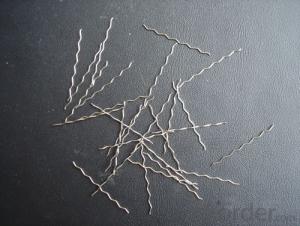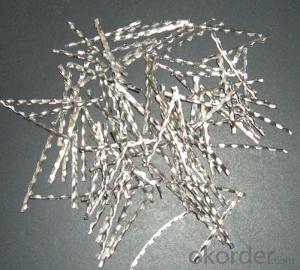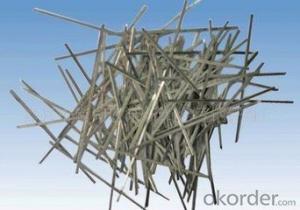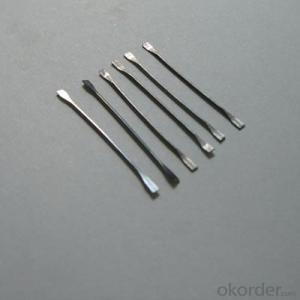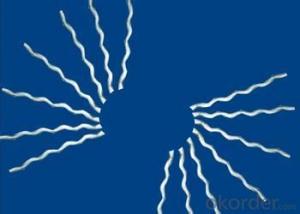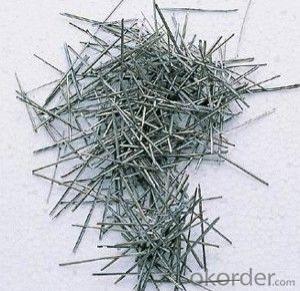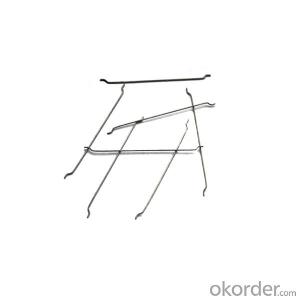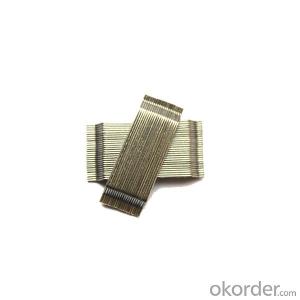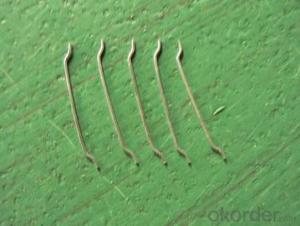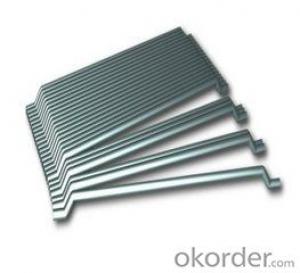Steel Fiber Wavy Corrugated Wavy and Reinforced
- Loading Port:
- Tianjin
- Payment Terms:
- TT OR LC
- Min Order Qty:
- 1000 kg
- Supply Capability:
- 250000 kg/month
OKorder Service Pledge
OKorder Financial Service
You Might Also Like
Quick Details
material: steel wire
shape: corrugated round fiber
appearance: clean and bright
usage: construction and concrete
Place of Origin: Shandong, China (Mainland)
Model Number: steel fiber
Product features
1>steel fiber
2>tensile strength: >1000Mpa
3>wire diameter:0.5mm-1mm
4>standard: ASTM A820
5>20 years factory
1>steel fiber material
low carbon steel wire or stainless steel wire
2>steel fiber type
hook ends steel fiber, Corrugated steel fiber,Wavy Steel Fiber, steel fiber reinforced, stainless steel fiber, etc.
3>steel fiber application
steel fiber are for concrete construction, greatly improves concrete bonding,etc.
Specifications
Length :20-60mm
Diameter :0.5-1.2
Tensile strength:600Mpa-900Mpa
Appearance :clear and bright steel wire
Style :corrugated round fiber
Picture

PP bag

any type

FAQ
we can produce any type steel fiber and of course we can make production according to your requirement
we have specilize in this field for almost 10 years ,with good quality and competitive price
- Q:Can melt extract stainless steel fiber be used in earthquake-resistant construction?
- Yes, melt extract stainless steel fiber can be used in earthquake-resistant construction. Stainless steel fibers offer enhanced strength and durability to concrete, making it more resistant to cracking and structural damage during earthquakes. The fibers act as reinforcement, helping to distribute and dissipate the energy generated by seismic activity. Additionally, stainless steel fibers have excellent corrosion resistance, ensuring the longevity and performance of the concrete structures in earthquake-prone areas. Therefore, incorporating melt extract stainless steel fiber into construction materials can significantly enhance the earthquake resistance of buildings and infrastructure.
- Q:How does the dosage of melt extract stainless steel fiber affect its performance in concrete?
- The performance of concrete is greatly influenced by the dosage of melt extract stainless steel fiber. The dosage, which refers to the amount of fiber added to the concrete mixture, has a profound impact on various properties of the concrete, including its strength, durability, and ability to resist cracks. When the dosage of stainless steel fiber is raised, it results in an increase in the overall tensile strength of the concrete. This is because the fibers act as reinforcement, distributing the tensile forces and preventing the formation and spread of cracks. By increasing the dosage, the flexural strength of the concrete can be significantly improved, making it more resistant to bending and reducing the risk of failure under load. Furthermore, the dosage of stainless steel fiber also affects the durability of the concrete. When the dosage is increased, the concrete becomes more resistant to chemical attacks, such as corrosion caused by chloride ions or sulfate attack. This is due to the protective barrier created by the stainless steel fibers, which prevent harmful substances from penetrating into the concrete matrix. Additionally, the dosage of stainless steel fiber has an impact on the crack resistance of the concrete. The fibers act as bridges across cracks, preventing them from widening and reducing crack propagation. Higher dosages of stainless steel fiber can enhance the concrete's ability to control cracks, resulting in better overall performance and longer service life. However, it is important to note that there is an optimal range for the dosage of melt extract stainless steel fiber. Excessive dosage can lead to issues like fiber balling, which hampers proper dispersion in the concrete mixture. This can negatively affect the workability of the concrete and lead to an uneven distribution of fibers, compromising their effectiveness. In conclusion, the dosage of melt extract stainless steel fiber has a significant impact on its performance in concrete. By carefully increasing the dosage within the optimal range, the concrete's tensile strength, durability, and crack resistance can be improved. It is crucial to consider the dosage thoughtfully to achieve the desired concrete properties while avoiding potential issues associated with excessive fiber content.
- Q:How does melt extract stainless steel fiber improve the flexural toughness of concrete?
- Melt extract stainless steel fiber improves the flexural toughness of concrete by enhancing its resistance to cracking and increasing its ductility. The fibers act as reinforcement, distributing stress more evenly throughout the concrete matrix and bridging micro-cracks that may occur. This results in improved flexural strength and increased resistance to bending and other forms of mechanical loading, ultimately enhancing the overall durability and performance of the concrete structure.
- Q:How does melt extract stainless steel fiber improve the fatigue resistance of concrete?
- Melt extract stainless steel fiber is known for enhancing the fatigue resistance of concrete due to its unique properties and characteristics. When added to concrete, these fibers create a three-dimensional reinforcement network that strengthens the material and improves its ability to withstand repetitive loading or cyclic stress. One of the main ways in which melt extract stainless steel fiber enhances the fatigue resistance of concrete is by increasing its crack resistance. As the concrete undergoes cyclic loading, cracks may develop and propagate, leading to eventual failure. However, the presence of stainless steel fibers helps to arrest the growth of these cracks, preventing them from spreading and improving the overall durability of the concrete. Moreover, the high tensile strength and excellent ductility of stainless steel fibers contribute to the fatigue resistance of concrete. These fibers can absorb and distribute stress throughout the concrete matrix, reducing the concentration of stress at specific points. This redistribution of stress helps to prevent the formation of microcracks and enhances the overall fatigue strength of the concrete. Additionally, the corrosion resistance of stainless steel fibers plays a crucial role in improving the fatigue resistance of concrete. Concrete is often exposed to harsh environmental conditions, such as moisture and chemical agents, which can lead to corrosion and deterioration of the material. However, stainless steel fibers are highly resistant to corrosion, ensuring the long-term integrity and durability of the concrete structure. Furthermore, melt extract stainless steel fibers also provide thermal stability to concrete. The expansion and contraction of concrete due to temperature variations can lead to the development of cracks and decrease its fatigue resistance. However, the presence of stainless steel fibers helps to minimize these thermal stresses by providing additional reinforcement and reducing the risk of crack formation. In conclusion, melt extract stainless steel fiber enhances the fatigue resistance of concrete through various mechanisms. It improves crack resistance, distributes stress, offers corrosion resistance, and provides thermal stability. By incorporating these fibers into concrete, the material becomes more resilient, durable, and capable of withstanding repetitive loading or cyclic stress, ultimately improving its fatigue resistance.
- Q:Can melt extract stainless steel fiber be used in architectural concrete?
- Yes, melt extract stainless steel fiber can be used in architectural concrete. It offers improved strength, durability, and crack resistance to the concrete, making it suitable for various architectural applications.
- Q:Can melt extract stainless steel fiber be used in precast bridge elements?
- Yes, melt extract stainless steel fiber can be used in precast bridge elements. It is commonly used to enhance the strength and durability of concrete in various construction applications, including precast bridge elements. The addition of stainless steel fiber helps improve the structural integrity and resistance to cracking and corrosion in these elements, making them suitable for use in bridges.
- Q:Can melt extract stainless steel fiber reduce the risk of early-age cracking in concrete?
- Yes, melt extract stainless steel fiber can reduce the risk of early-age cracking in concrete. Early-age cracking in concrete is commonly caused by shrinkage, temperature changes, and lack of adequate tensile strength. By adding melt extract stainless steel fibers to the concrete mix, the overall tensile strength of the concrete is increased. These fibers act as reinforcement, effectively distributing stresses and preventing crack initiation and propagation. Additionally, the stainless steel fibers help to control the shrinkage of concrete by reducing the width and length of cracks that may occur. This reduces the risk of early-age cracking and improves the durability and longevity of the concrete structure.
- Q:Can melt extract stainless steel fiber be used in tunnel linings or underground structures?
- Yes, melt extract stainless steel fiber can be used in tunnel linings or underground structures. The use of stainless steel fiber in tunnel linings and underground structures offers several benefits. Firstly, stainless steel fiber enhances the overall strength and durability of the structure. Stainless steel has high tensile strength and is resistant to corrosion, making it an ideal material for reinforcing tunnel linings. The addition of stainless steel fiber to concrete or shotcrete mixes improves its flexural strength and crack resistance, thereby increasing the longevity and structural integrity of the tunnel lining. Secondly, stainless steel fiber provides improved fire resistance. In the event of a fire, stainless steel fiber can help to minimize the spread of flames and reduce the risk of structural collapse. This is particularly important in underground structures where fire safety is a crucial consideration. Furthermore, stainless steel fiber can also contribute to the overall safety of tunnel linings and underground structures. By improving the crack resistance and structural stability, it reduces the risk of sudden failures or collapses, ensuring the safety of both the structure itself and the people using it. In summary, melt extract stainless steel fiber is highly suitable for use in tunnel linings and underground structures due to its strength, corrosion resistance, fire resistance, and safety benefits. Its addition to concrete or shotcrete mixes can significantly enhance the overall performance and longevity of these structures.
- Q:Can melt extract stainless steel fiber be used in precast concrete wall panels?
- Yes, melt extract stainless steel fiber can be used in precast concrete wall panels. Stainless steel fiber is commonly used in concrete applications to enhance the mechanical properties of the material, such as improving its tensile strength, toughness, and durability. In precast concrete wall panels, the addition of stainless steel fibers can provide additional reinforcement and reduce the risk of cracking and shrinkage. The fibers help to distribute stresses more evenly throughout the concrete, improving its overall structural performance. Melt extract stainless steel fibers are particularly suitable for precast concrete applications due to their high melting point and corrosion resistance. These properties make them highly durable and capable of withstanding harsh environmental conditions, such as exposure to freeze-thaw cycles, chemicals, and moisture. Moreover, melt extract stainless steel fibers are typically available in various lengths, diameters, and aspect ratios, allowing for customization based on the specific requirements of the precast concrete wall panels. This flexibility in fiber selection ensures that the desired mechanical properties of the concrete can be achieved. Overall, melt extract stainless steel fiber is a suitable choice for reinforcing precast concrete wall panels, as it enhances their strength, durability, and performance.
- Q:How does the fiber length affect the performance of melt extract stainless steel fiber in concrete?
- The fiber length of melt extract stainless steel fibers has a significant impact on the performance of these fibers in concrete. Longer fiber lengths generally result in improved mechanical properties and performance of the concrete. Firstly, longer fiber lengths provide a greater surface area for bonding with the concrete matrix. This enhanced bond improves the overall strength and load-bearing capacity of the concrete, making it more resistant to cracking and deformation. Additionally, the increased interfacial bond between the fibers and the concrete matrix enhances the fiber's ability to distribute and transfer stresses, resulting in improved durability and increased resistance to impact and fatigue. Moreover, longer fibers also enhance the crack-bridging ability of the concrete. When cracks form in the concrete, longer fibers are more capable of spanning the cracks and preventing their propagation. This crack-bridging ability helps to maintain the integrity of the concrete structure and prevents the cracks from widening, reducing the potential for further damage. Furthermore, longer fibers also improve the post-crack behavior of the concrete. As cracks propagate, the longer fibers can redistribute the stresses and prevent localized failure, resulting in increased ductility. This ductility allows the concrete to undergo greater deformation before failure, enhancing its ability to withstand dynamic loads and sudden impacts. However, it is important to note that there is an optimum fiber length for achieving these desired performance characteristics. Very long fibers may lead to entanglement and clustering, which can negatively affect the workability of the concrete mix and result in an uneven distribution of fibers. On the other hand, very short fibers may not provide sufficient reinforcement to the concrete and may not effectively bridge cracks. In conclusion, the fiber length of melt extract stainless steel fibers plays a crucial role in determining their performance in concrete. Longer fiber lengths generally lead to improved mechanical properties, enhanced crack-bridging ability, and increased post-crack behavior. However, finding the optimal fiber length is essential to achieve the desired properties without compromising other aspects of the concrete mix.
1. Manufacturer Overview |
|
|---|---|
| Location | |
| Year Established | |
| Annual Output Value | |
| Main Markets | |
| Company Certifications | |
2. Manufacturer Certificates |
|
|---|---|
| a) Certification Name | |
| Range | |
| Reference | |
| Validity Period | |
3. Manufacturer Capability |
|
|---|---|
| a)Trade Capacity | |
| Nearest Port | |
| Export Percentage | |
| No.of Employees in Trade Department | |
| Language Spoken: | |
| b)Factory Information | |
| Factory Size: | |
| No. of Production Lines | |
| Contract Manufacturing | |
| Product Price Range | |
Send your message to us
Steel Fiber Wavy Corrugated Wavy and Reinforced
- Loading Port:
- Tianjin
- Payment Terms:
- TT OR LC
- Min Order Qty:
- 1000 kg
- Supply Capability:
- 250000 kg/month
OKorder Service Pledge
OKorder Financial Service
Similar products
New products
Hot products
Related keywords
